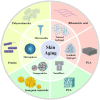Tailoring biomaterials for skin anti-aging
- PMID: 39285945
- PMCID: PMC11402947
- DOI: 10.1016/j.mtbio.2024.101210
Tailoring biomaterials for skin anti-aging
Abstract
Skin aging is the phenomenon of degenerative changes in the structure and function of skin tissues over time and is manifested by a gradual loss of skin elasticity and firmness, an increased number of wrinkles, and hyperpigmentation. Skin anti-aging refers to a reduction in the skin aging phenomenon through medical cosmetic technologies. In recent years, new biomaterials have been continuously developed for improving the appearance of the skin through mechanical tissue filling, regulating collagen synthesis and degradation, inhibiting pigmentation, and repairing the skin barrier. This review summarizes the mechanisms associated with skin aging, describes the biomaterials that are commonly used in medical aesthetics and their possible modes of action, and discusses the application strategies of biomaterials in this area. Moreover, the synergistic effects of such biomaterials and other active ingredients, such as stem cells, exosomes, growth factors, and antioxidants, on tissue regeneration and anti-aging are evaluated. Finally, the possible challenges and development prospects of biomaterials in the field of anti-aging are discussed, and novel ideas for future innovations in this area are summarized.
Keywords: Biomaterials; Medical aesthetics; Plastic surgery; Skin anti-aging; Tissue regeneration.
© 2024 The Authors. Published by Elsevier Ltd.
Conflict of interest statement
The authors declare that they have no known competing financial interests or personalrelationships that could have appeared to influence the work reported in this paper.
Figures










Similar articles
-
Multi-Center, Double-Blind, Vehicle-Controlled Clinical Trial of an Alpha and Beta Defensin-Containing Anti-Aging Skin Care Regimen With Clinical, Histopathologic, Immunohistochemical, Photographic, and Ultrasound Evaluation.J Drugs Dermatol. 2018 Apr 1;17(4):426-441. J Drugs Dermatol. 2018. PMID: 29601620 Clinical Trial.
-
Exosomes based advancements for application in medical aesthetics.Front Bioeng Biotechnol. 2022 Dec 20;10:1083640. doi: 10.3389/fbioe.2022.1083640. eCollection 2022. Front Bioeng Biotechnol. 2022. PMID: 36605254 Free PMC article. Review.
-
Silk biomaterials in wound healing and skin regeneration therapeutics: From bench to bedside.Acta Biomater. 2020 Feb;103:24-51. doi: 10.1016/j.actbio.2019.11.050. Epub 2019 Dec 2. Acta Biomater. 2020. PMID: 31805409 Review.
-
The role of the ImmunatuRNA® complex in promoting skin immunity and its regenerative abilities: Implications for antiaging skincare.J Cosmet Dermatol. 2024 Apr;23(4):1429-1445. doi: 10.1111/jocd.16131. Epub 2023 Dec 26. J Cosmet Dermatol. 2024. PMID: 38146634
-
Innovations in Skin and Soft Tissue Aging-A Systematic Literature Review and Market Analysis of Therapeutics and Associated Outcomes.Aesthetic Plast Surg. 2023 Aug;47(4):1609-1622. doi: 10.1007/s00266-023-03322-1. Epub 2023 May 8. Aesthetic Plast Surg. 2023. PMID: 37154849 Free PMC article. Review.
References
Publication types
LinkOut - more resources
Full Text Sources

